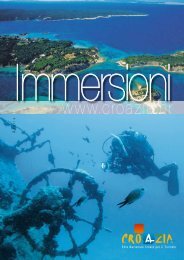Diving
Diving
Diving
Create successful ePaper yourself
Turn your PDF publications into a flip-book with our unique Google optimized e-Paper software.
TA 36 (ex-Stella Polare) – Rabac – Brestova<br />
This torpedo escort destroyer of smaller dimensions (82 m long, with<br />
a beam of 8.6 m) was designed for convoy escort duties and for antisubmarine<br />
operations. Its construction began in the Rijeka shipyard,<br />
commissioned by the Italian Navy (Stella Polare), but following Italy’s<br />
capitulation it was commandeered by the German Navy, designating it<br />
TA 36. It was launched on July 11, 1943 and sank on March 18, 1944<br />
when, due to a navigational error, it struck an underwater mine some<br />
800 m north of the wharf at Brestova. Although Germans were aware of<br />
the minefield, the ship’s captain was taking a forbidden route. It was also<br />
noted that the site of sinking was recoded at a wrong location, where, of<br />
course, it could not be located. The wreck was discovered accidentally<br />
and its condition shows the true fate that befell the vessel. More than 40<br />
German sailors died in this incident. The wreck is officially categorized as<br />
a war grave, and as such is under the protection of the Ministry of Culture<br />
of the Republic of Croatia. Consequently, diving is possible only in the<br />
company of licensed diving centres. The coordinates at which the wreck<br />
lies are 45 o 08’ N, 14 ’ E, at a depth of 45 to 65 m. Its twin barrelled guns<br />
and anti-aircraft guns, as well as the triple-barrelled torpedo launchers<br />
with torpedoes still in them have remained in place. The explosion broke<br />
the ship in two immediately adjacent to the command bridge. The bow<br />
came to rest about 150 m from the rest of the ship and is of no interest to<br />
divers.<br />
∆ Gorgonians cover numerous sea walls with their<br />
luxuriant fan-shaped branches and crowns<br />
The sea horse is a gentle and charming inhabitant that<br />
“grazes” on the underwater meadows of Posidonia oceanica<br />
∆<br />
Tihany is a cargo steam ship formerly belonging to the Austro-Hungarian<br />
Navy, which sank on February 12, 1917, when it ran aground on the isle<br />
of Školjić at the entrance to the island port of Unije. The vessel went<br />
down during an attempt to tow it off the coast, right by the sloping shores<br />
of the isle against which it ran aground. The vessel was 60 m long, 7 m<br />
in beam and lies at a depth of 33 to 39 m. In its immediate vicinity the<br />
remains of ancient ceramics can also be seen, pointing to the fact that<br />
this location has been a danger to shipping for millennia, and that many<br />
other ships went down at this location. The ship’s timbers decayed totally,<br />
making it possible to inspect the interior, a large cargo hold.<br />
∆ Numerous differently coloured starfish feed on<br />
sea urchins – somewhat repugnant members of<br />
Adriatic fauna<br />
Croatian National Tourist Board<br />
17




